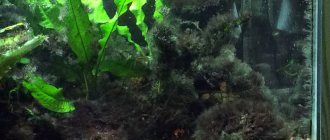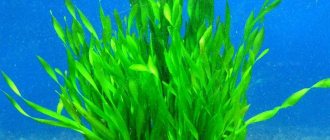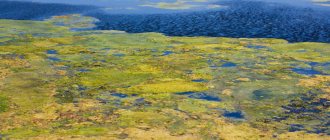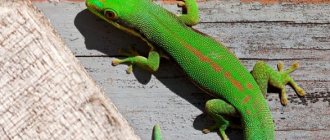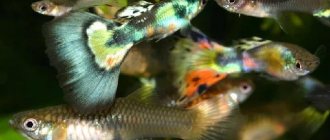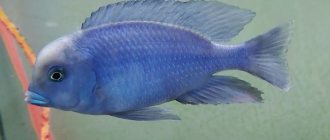Many novice aquarists consider Cladophora to be a moss or a plant with an unusual shape. In fact, it is an unusual algae, which is small bushes with thread-like foliage. Scientists count about 200 species of this plant, but only two can be found in aquariums. In nature, cladophorans live in freshwater bodies of water and some seas. They contain a lot of cellulose, so algae are often extracted for industrial needs: to make durable paper, alcohol or glue.
Kinds
Aquarists encounter two types of Cladophora:
- Globular (Egagropyla Linnaeus) is a noble plant that is specially placed in the aquarium as decoration. It looks beautiful in water and has a number of useful properties. In appearance it resembles a ball, velvety and soft.
- Stray - it is not specifically placed in the aquarium, but is usually brought along with other plants or on the scales of fish. It consists of hard filaments that float in the aquarium and multiply quickly.
Other species of this plant are not found in aquariums, but are found only in rivers or other bodies of water.
Compatibility
Egagropila is most often planted in spawning grounds and nurseries, as well as in aquariums with shrimp. They eat thin threads of algae well, thus removing overgrown parts, and the fry feast on ciliates that accumulate in the structure of the plant.
Before placing mosses in an aquarium, you should consider the requirements of other fish and plants. Cladophora does not like warm temperatures, so you should select neighbors for it, taking this feature into account.
Globular algae are not friendly with catfish, crayfish and goldfish. They actively eat the plant, so if such phenotypes are present, there will be little left of the moss balls. Shrimp also like to eat mosses, or hide between thin threads, but they keep Egagropilus with them if there are not very many shrimp.
This is interesting: in Japan, cladophora is a family plant, and is passed on from father to son. According to legend, the one who gets rid of the aegagropile will be unhappy.
Beneficial properties of algae
The spherical cladophora has gained its popularity among aquarists for its beneficial properties:
- it has high decorative qualities, looks unusual in an aquarium and has a pleasant color;
- passes large volumes of water through itself, filtering it;
- cleans liquid from nitrates;
- is an additional source of oxygen for the inhabitants of the tank;
- collects fish waste products and particles of their food on its surface, preventing the water from becoming polluted.
It is good to keep it with fry and small crustaceans. The shrimp regulate the diameter of the balls by eating the soft threads. Small fish obtain additional food from the bushes - protozoan microorganisms and ciliates. They become an additional source of food for the fry.
Harm
Filamentous algae is dangerous because it can spread throughout the entire aquarium in just a few days. It entangles plants, leading to their death. It also appears on filters, making their work difficult. Small fish become entangled in the threads of the parasite, and the products of its vital activity themselves are toxic and negatively affect the entire ecosystem as a whole.
How to get rid of a stray species
Stray Cladophora is a weed that is best to get rid of. If you don’t do this, then very soon it will take over the entire aquarium. Usually the first colonies of this algae are located in areas of stagnant water. Then it spreads along the bottom and walls of the aquarium, entangling hoses and tubes.
If you let the spread of stray cladophora take its course, it will soon interfere with the inhabitants of the aquarium:
- reduces the amount of light entering the water;
- prevents the enrichment of water with oxygen;
- absorbs useful minerals from water;
- interferes with the free movement of fish.
There are several ways to remove algae. While their colony has not grown too large, you can use a regular net. With its help, it is easy to catch individual threads of stray cladophora.
Each detached weed bush is capable of forming a new colony. Therefore, first drive the algae into one place by directing the oxygen supply hose to its threads.
If the colony has grown, mechanical removal may be ineffective. Therefore, it is worth using other methods:
- Using young Amano shrimp. They clean the aquarium well if you put them in it hungry. For a 100-liter tank you will need at least 30 individuals.
- Chemical method of control. To do this, you will need to stop filtering the water, turn off the compressor, and place the fish and other inhabitants in a separate container. For 100 liters of water you will need 10 ml of algaecide; it is released into the water with a syringe into places where algae accumulate. Such treatments will need to be done at least 5-10. Filters and aeration can only be turned on 20-30 minutes after using the chemical.
Most aquarists prefer to combat stray cladophora by using a chemical.
In nature
It is found in the form of colonies in Lake Akan, Hokkaido and Lake Myvatn in northern Iceland, where it has adapted to low light, currents, and the nature of the bottom. It grows slowly, about 5 mm per year. In Lake Akan, the egagropila reaches especially large sizes, up to 20-30 cm in diameter.
In Lake Mývatn it grows in dense colonies, at a depth of 2-2.5 meters and reaches a size of 12 cm. The rounded shape allows it to move with the current, and ensures that the process of photosynthesis will not be interrupted, regardless of which side it is turned towards the light.
But in some places these balls lie in two or three layers! And everyone needs light. The inside of the ball is also green, and is covered with a layer of dormant chloroplasts, which become active if the algae breaks apart.
Maintenance and care
If aquarists fight a harmful species with all available means, they try to tame a beneficial one - to create conditions for it that are as convenient as possible for growth. You can achieve optimal development of Linnaeus' aegropylus throughout the year if you:
- You will maintain a fairly low temperature in the aquarium - from 18 to 20 degrees.
- Every week you will refresh up to 30% of the total water volume. Constant filtration will help maintain an attractive appearance. The plant develops better in clean water.
- Achieve optimal levels of water hardness and acidity in your aquarium. If the environment is alkaline and the water is excessively hard, the plant will begin to disintegrate into separate fragments and eventually die.
- Moderately illuminate the underwater garden with fluorescent lamps with a power of about 0.5 W/l.
It is permissible to slightly salt the water in the aquarium if its other inhabitants require it. Cladophora can withstand up to 5% salt content in water.
If a coating appears on its surface or the color of the algae turns brownish, then it is necessary to rinse the plant with clean water. Then squeeze it lightly with your hand and return it to the aquarium. To avoid introducing chlorine particles into the tank, allow the water for cleaning cladophora to settle beforehand.
Blackout
Pros:
- the method destroys not only filamentous algae, but also other types of algae, leaving them practically no chance.
Minuses:
- darkening can kill aquarium plants, especially those that require good lighting.
Darkening the aquarium is used by many experienced aquascapers.
Before the procedure you must:
- Remove as much algae as possible mechanically.
- Trim overgrown plant leaves.
- Siphon the aquarium, clean the filter, change the water by 50-70%.
- Turn off the lights and carbon dioxide supply.
- Turn on filtration and completely darken the aquarium.
- In case of severe infestation, you can add a product containing an algaecide and then wait three days.
During this time, the algae will die, but the plants and living inhabitants will remain unharmed. The aquarium is fully launched on the fourth day. If there is too much dead algae in the tank, they should be removed with a net and the filter should be rinsed thoroughly to prevent the release of ammonium. Turn on the lighting and CO2 supply - first to a minimum, then gradually increase over several days. To restore normal plant growth, add nitrogen and phosphorus.
Ruslan Ivanyushin (aka naman)
Russian aquascaper
Filamentous hair was once thought to be caused by high iron levels, but this is not true. If you reduce the dose of the microelement to 0.1 mg/l, the algae will not die, but the plants will begin to experience chlorosis, a disease associated with Fe deficiency, from which they will stop growing.
How to plant
One of the features of the aegropile is that it does not need soil for planting. Under normal conditions, it is laid out on the bottom and then moves freely around the aquarium. During the daytime, the process of photosynthesis is activated in its threads, as evidenced by the appearance of small bubbles on the surface of the balls. At this moment the algae floats up. As oxygen is consumed, they sink to the bottom. This usually happens in the evening.
Some aquarists prefer that the algae does not float in the water, but only decorates the bottom. In this case, they carefully open the ball with scissors (you need to wash it first and use only a treated tool), and then lay out the resulting flap on a large stone, securing it with fishing line. The resulting decoration is lowered into the aquarium. After some time, the fishing line will not be visible, and the algae will completely entangle the stone.
Preventing the appearance of threads
It is quite possible to avoid the growth of lower vegetation if you follow a number of simple recommendations:
- Timely cleaning of the aquarium with the obligatory removal of dead plant leaves
- Organizing proper artificial lighting
- Avoid prolonged exposure to direct sunlight
- Compliance with daylight hours - no more than 8 hours
- Normalization of carbon dioxide and oxygen intake
- Creating favorable conditions for the growth of aquarium plants
- Feeding the fish according to their needs, avoiding contamination of the aquarium with excess food
- Monitor nitrate, phosphate and ammonia concentrations using specific tests.
Algae are participants in a natural biological process. However, there should be very few of them. If the filament in the aquarium begins to grow rapidly, it means that the biological balance is disturbed, and it is time to use all forces to fight the lower plants. At the same time, it is important not just to eliminate the problem, but to understand the root cause of its occurrence, so that the fight is effective and not in vain.
Reproduction
In order for the algae to grow, you can use two ways:
- The temperature rises to 24-26 degrees. In such conditions, active growth of the plant is observed, its disintegration into separate fragments. They need to be collected and placed in a separate container of any volume; after some time, new spherical cladophores will be obtained from these fragments. It is not recommended to keep the temperature in the main aquarium above 22 degrees for more than 2 months, as in this case the plant will begin to die. In a separate container, set the temperature to about 20 degrees.
- If you don’t want to wait until the aegropiles begin to disintegrate on their own, help the plant without changing the conditions. To do this, select the largest specimen, tear it apart with your hands and place these parts in a separate container with cool water.
To get new algae specimens, you will have to wait a while. Create optimal conditions for their maintenance, then the growth will be fast and uniform.
Why doesn't Cladophora grow?
There are several reasons why a plant could not be propagated or why it does not grow for a long time:
- The hardness and acidity of the water is incorrectly set;
- insufficient water purity;
- the activity of shrimp eating the strings of balls;
- damage by green or blue-green algae.
Most often, aquarists simply do not wait for new cladophora balls to form. This process can take up to 1 year.
History of the study of Cladophora
At one time, the active spread of Cladophora throughout the natural water bodies of European countries contributed to the rapid study and classification of this plant. The first scientist to describe Aegagropyla in detail was the famous Carl Linnaeus. In the middle of the 18th century, this Swedish naturalist presented to the world his scientific work, in which the plant under study was named Conferva aegagrophilia - “leafless algae” (the closest in meaning, an exact translation into Russian is impossible).
The study of this algae began in the 18th century.
Since then, in scientific terminology, the designation of Cladophora has changed several times. Experts could not come to a consensus until 2002, when biologists decided to call Cladophora in the scientific field Aegagropila linnaei (in Latin - Aegagropila linnaei) in honor of the great researcher who was the first to study this plant.
Unlike scientists, who nevertheless came to an agreement on the name Cladophora, ordinary lovers of aquarium flora call the plant differently:
- ball moss;
- mossy ball;
- lake moss, etc.
Residents of Germany call this plant Russian moss ball. And the Japanese poetically call the egagropile marimo.
Fertilizers
Cladophore does not require any fertilizing during cultivation. It has enough minerals that get into the water from fish food. Much more important for her:
- regularly replace some of the water with clean and settled water;
- moderate lighting of the aquarium;
- using a filter in the tank.
This is an unpretentious plant that any aquarist can handle. It develops well in clean and cool water. You can preserve its beauty by regularly washing the surface of the cladophora ball. If you do everything correctly, you will get a beautiful emerald plant that looks original in the aquarium.
Ways to fight
The fight against filamentous algae is a difficult and troublesome task, so it is important to start it at the first sign of their appearance. There are several common ways to effectively eliminate a dangerous plant, proven by experience and time.
Mechanical treatment of the aquarium
There are a large number of tools on sale for cleaning an aquarium from green filamentous algae: scrapers, special brushes and even special magnets. You can remove an aquatic plant from the walls of the tank using a scraper, the principle of which is similar to a razor.
When carrying out this procedure, it is important to make sure that there are no traces of algae left on the glass, otherwise all efforts will be useless. After treatment with a scraper, the surface can be additionally wiped with a regular dish sponge.
Driftwood, stones and other decorative elements are cleaned with a brush. This procedure is painstaking and requires some patience. Using brushes, filters are also cleaned, where filament also prefers to settle.
Use of chemicals
To combat many types of aquatic plants, special chemicals are commercially available that suppress their growth and spread. They are available in the form of tablets or drops. Algae control products come in fast-acting and slow-acting forms. The former allow you to kill the pest almost in one day, but due to their aggressive composition they greatly harm the ecosystem as a whole. They are used in advanced cases. Long-acting drugs should be used when the very first signs of filament appear, as well as to prevent its formation.
Traditional methods
Very often, household chemicals and certain types of medicines that are in every first aid kit are used to combat this pest.
This:
- White. An aggressive but effective way to get rid of threads. Before use, it should be diluted with water in a ratio of 1:30, after which the leaves of the affected plants and decorative elements of the aquarium are dipped into this solution.
- Hydrogen peroxide. Added to the tank at the rate of 15 g/l. The product is safe for the ecosystem, but harmful to filamentous and other types of algae.
- Antibiotics (erythromycin, penicillin). They suppress algae growth well without affecting the condition of the aquarium inhabitants.
Using aquarium nurse fish and shrimp
The biological method of combating filament is the most natural and effective. There are some types of fish whose main food is algae - these are guppies, platies, and Siamese algae eaters. This method has one serious drawback - the possible incompatibility of some species.
Shrimp also actively act as a kind of cleaner. They do their job very efficiently. However, this requires a large number of them, and besides, they themselves are an excellent food for many species of fish.

